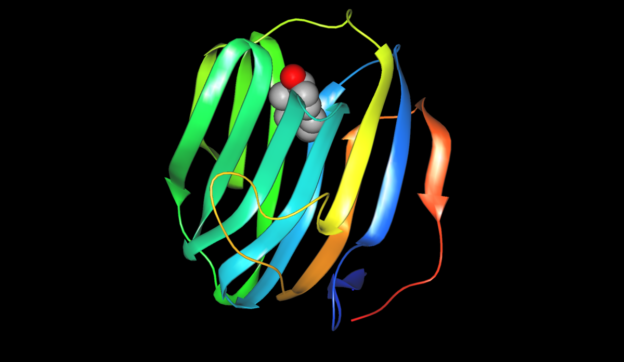Hormone-Binding Proteins
Table of Contents
Image: “Sex hormone-binding globulin.” by Doxepine – Own work. License: Public Domain
Hormone-Binding Proteins
These proteins regulate the amount of hormone reaching the target cells. They also regulate the non-protein-bound or ‘free’ circulating active steroid hormones, which are considered as the ‘primary gatekeepers of steroid action.’
Albumin has limited specificity and affinity for steroids. SHBG and CBG, unlike albumin, have a higher affinity for steroids and control the access to target tissues. SHBG binds with the androgens and estrogens, while CBG binds glucocorticoids and progesterone. Both these binding proteins are glycoproteins but are structurally different.
Plasma SHBG and CBG levels vary with their production in the liver which also varies with age, development and different physiological or pathophysiological conditions. Various pathologies are associated with disturbed production of SHBG and CBG and their abilities to bind hormones.
Sex Hormone-Binding Globulin – SHBG
Sex hormone-binding protein is mainly produced in the liver and in small amounts in the brain, testes, uterus and placenta. This binding protein carries:
- Dihydrotestosterone
- Testosterone
- Estradiol/estrone
DHEA and androstenedione are also almost completely bound to albumin, but their affinity to SHBG is 4-5 times greater. It is bound to biologically active androgens and estrogens. Levels of SHBG vary throughout life, depending on the hormonal and metabolic factors. In males, more of the binding protein is occupied as compared to females because males have more androgens. Other steroid hormones such as progesterone, cortisol and other corticosteroids are bund to transcortin.
Conditions that cause an increase in production
In some conditions, the production of SHBG is increased. These include:
- Increased growth factors
- Increased estrogen
- Hyperthyroidism
- Pregnancy
- Anorexia nervosa
Drugs: Various drugs also increase the production of these proteins. Such drugs are:
- Estrogens
- Soy Isoflavones (licorice)
- Synthetic progestins
- Glucocorticoids
- Growth hormone
- Phenytoin
Conditions that cause a decrease in production
In some conditions, the production of SHBG is decreased. Such conditions cause increased level of androgens in the blood or increased transcortin levels. These include:
- Polycystic ovary syndrome
- Diabetes
- Hypothyroidism
- Obesity.
- Cushing syndrome.
- Acromegaly.
Drugs: Various drugs also decrease the production of these proteins. In this group fall
- Exemestane
- Testosterone
- Anabolic steroids
Thyroid-Binding Globulin (TBG)
Thyroid-binding globulin (TBG) is also formed in the liver and released into circulation to bind reversibly to the thyroid hormonespresent in the circulation, i.e., T3 and T4 primarily. Affinity of this binding protein is more for T4. Its affinity for various forms of thyroid hormones varies as: T4>T3>T1/T2.
The normal levels of TBG in circulation is 1.1- 2.1 mg/dl. An increase in this level leads to increase in the total T4 and T3 levels but not an increase in the free hormone activity.Newborns have a relatively very high level of TBG.
Conditions that cause an increase in production
- Acute intermittent porphyria
- HIV
- Severe liver disease
- Hypothyroidism
- Pregnancy (normal)
Drugs:
- Estrogens, circulating thyroid/free T3 + T4, Tamoxifen
- Heroin
- Mitotane
- Methadone
- Fluorouracil
- Phenothiazines
Conditions that cause decrease in production
- Kidney failure
- Acute illness
- Acromegaly
- Hyperthyroidism
- Malnutrition
Drugs:
- Testosterone
- Valproic Acid
- Phenytoin
- Slow release nicotinic acid
- Anabolic steroids
- Glucocorticoids (Prednisone)
Corticosteroid-Binding Globulin (CBG) (or transcortin)
Corticosteroid-binding globulin (CBG), also called transcortin,is an alpha globulin secreted by the liver after expression of the SERPINA6 gene that encodes it. It carries various hormones in different levels as shown:
- 75% of cortisol.
- 78% of corticosterone.
- 17% of aldosterone.
- 18% of progesterone
Other hormones carried by transcortin include 4% f testosterone and 11-Deoxycorticosterone (DOC), which is an aldosterone precursor. It is the main determinant of circulating plasma cortisol levels in humans. CBG has maximum affinity for cortisol. More than 90% of the cortisol is carried by transcortin. Its level is raised in the prepubertal age, during pregnancy and after use of estrogen as medication.
Production is decreased in the following conditions
- Hypoproteinemia
- Cushing’s syndrome
- Corticoid treatment
- Some cases of vitamin B12 deficiency
- Septic shock
- Drugs: Various drugs can also reduce the production of transcortin, like use of androgens.
Serum Albumin
Serum albumin is also a hormone-binding protein which is produced in the liver. It is one of the most abundant proteins in the blood. It binds with steroid hormones and other small lipophilic molecules, non-specifically. It binds with multiple hormones, including:
- Thyroid hormones
- Fat soluble hormones
- Fatty acids to liver
- Unconj. bilirubin
- Various minerals
Albumin binds all the steroid hormones with the same affinity. Still, 99% of the albumin binding sites remain open. With age, albumin concentration is decreased. In some conditions, production of albumin is increased. These conditions include:
- Dehydration
- Congestive heart failure
- Poor protein utilization
- Glucocorticoid excess (adrenal overproduction of cortisol, tumor)
Drugs:
- Anabolic steroids
- Androgens
- Growth hormone
- Insulin
Similarly, in few conditions production of albumin is decreased. These include:
- Kidney disease like nephrotic syndrome
- Liver Disease like cirrhosis
- Pregnancy
- Severe malnutrition
- Conditions of decreased nutrients:
- Crohn’s disease
- Low protein diet
- Tropical sprue
- Whipple’s disease
- Insufficient anabolic hormone (DHEA, growth hormone, testosterone)

Comentários
Enviar um comentário